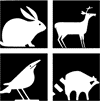Wildlife Damage Management, Internet Center for
Date of this Version
2009
Document Type
Article
Abstract
Despite a substantial amount of information available on bird and other wildlife strikes at large international airports, relatively few researchers have considered bird hazards at smaller general aviation (GA) airports and airfields. However, small airports often are located in rural areas, and the potential for wildlife strikes may be significant, especially because airworthiness standards related to bird strikes are much less stringent for GA aircraft compared to commercial aircraft. In this study, we conducted habitat assessments (onsite land-cover evaluations and Geographic Information System analyses) and seasonal bird surveys (walking transects) over a period of 1 year at 10 small airports in the state of Indiana, USA. Across all airports, the 3 most abundant habitat types were short (mowed) grass (mean = 40.2% of total airport area), soybean fields (10.3%), and corn fields (9.5%). At least 2 types of bird attractants (e.g., standing water, agricultural fields, woodlots) were present at each airport property, although most airports had 5 to 7 types. Seven species groups (American kestrel [Falco sparverius], blackbirds-starling, crows-ravens, mourning dove [Zenaida macroura], shorebirds, sparrows, and swallows) each were present at 9–10 of the airport properties during 1 or more seasons. The most numerous species group was blackbirds-starling, although the abundance of this and most other species groups varied widely across seasons and airports. Our results indicate that small airports in Indiana contain many bird attractants and harbor substantial numbers of birds hazardous to aviation. Management of wildlife hazards at small airports is especially challenging, given that many such airports have limited resources available for design and implementation of effective wildlife management programs. Future research should evaluate the suitability of alternative habitat types and agricultural crops that are cost-effective but compatible with effective management of wildlife hazards to aviation.



Comments
Published in Proceedings of the 13th WDM Conference (2009). (J. R. Boulanger, editor). 2009.